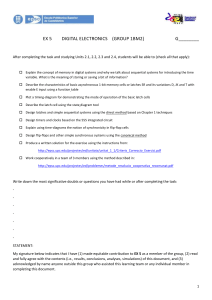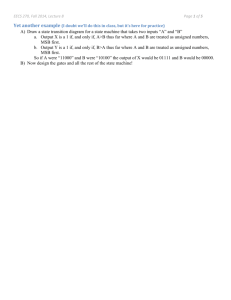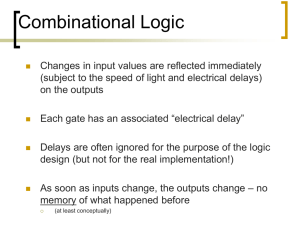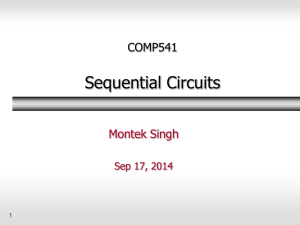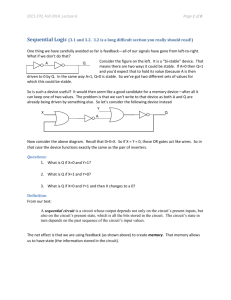EEE 122Ch5 Latches and FlipFlops
advertisement
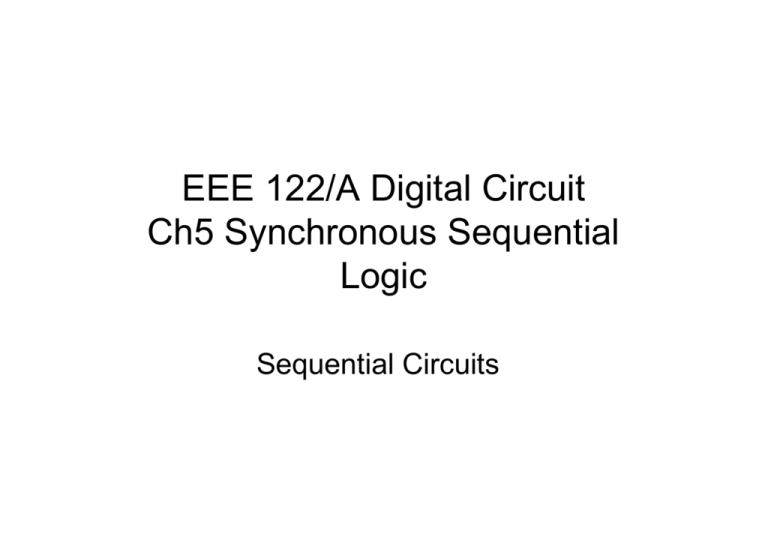
EEE 122/A Digital Circuit Ch5 Synchronous Sequential Logic Sequential Circuits SEQUENTIAL LOGIC • Sequential Circuit • Memory Elements – Latches: S-R Latch, D Latch – Flip-flops: D flip-flop, J-K flip-flops, T flip-flops • Analysis of Clocked Sequential Circuit – – – – State Equations State Table State Diagram Analysis with Flip-Flops: D, JK, T • State Reduction and Assignment • Design Procedure • Two types of logic circuits – Combinational – Sequential • Combinational Circuit • Sequential Circuit – The outputs depend The outputs depend on both entirely on the current present state of storage inputs. element and current inputs. e.g.: Decoder, encoder, multiplexer, demultiplexer, Boolean function logic inputs : : inputs : : Combinational Logic :: Combinational Logic Circuit outputs Present state Storage :: outputs • Two types of sequential circuits: – Synchronous: is a system whose behavior can be determined from the knowledge of its signal at discrete instants of time – Asynchronous: is a system whose behavior depends upon the input signals at any instant of time and the order in which the inputs change Synchronous Clocked sequential Circuit Inputs Combinational Logic Outputs pulses Storage Clock pulses Storages are memory elements MEMORY ELEMENTS • Memory element: is a device which can remember value indefinitely, or change value on command from its inputs. command Memory element Q stored value Memory Elements utilize Bistable logic devices called flip-flops. • Memory element with clock. Flip-Flops can change state only during a pulse transition Two types of triggering Pulse-triggered Edge-triggered Pulse-triggered Used with latches ON = 1, OFF = 0 Edge-triggered Used with Flip-flops Positive edge-triggered ON = from 0 to 1; OFF = other wise Negative edge-triggered: ON = from 1 to 0; OFF = other wise command Q Memory element stored value clock • Clock is usually a square wave. Positive pulses Positive transition edges (0 to 1) Negative transition edges (1 to 0) Latches • Latches is the basic types of Flip-Flops, operate with signal levels • They are useful for storing binary information & for designing of asynchronous sequential circuits SR Latch • SR latch: is a circuit with cross-coupled NOR gates or cross coupled NAND gates • Two inputs: S and R. • Two complementary outputs: Q and Q'. SR Latch • Active-high input S-R latch: • Latch with NOR gates is said to be active high 10100 R Q 11000 10001 S Q' 0 0 1 1 0 S 1 0 0 0 1 • Block diagram: S Q R Q' R 0 0 1 0 1 Q Q' 1 0 initial 1 0 (afer S=1, R=0) 0 1 0 1 (after S=0, R=1) 0 0 invalid! SR Latch • Characteristic table for active-high input S-R latch: S R 0 0 1 1 0 1 0 1 S R Q Q' 0 0 NC NC 1 0 1 0 1 1 1 0 0 0 1 0 No change. Latch remained in present state. Latch SET. Latch RESET. Invalid condition. Q(t+1) No change Q(t) 0 Reset 1 Set indeterminate Q(t+1) = current state Q(t) = last state SR Latch Active-low input S-R latch active-low input S-R latches, are built of NAND gates. R S Q Q' S 1 1 0 1 0 R 0 1 1 1 0 Q Q' 0 1 initial 0 1 (afer S=1, R=0) 1 0 1 0 (after S=0, R=1) 1 1 invalid! when R=0 and S=1, the latch is reset (i.e. Q becomes 0) – when R=1 and S=0, the latch is set (i.e. Q becomes 1) – when S=R=1, it is a no-change command. – when S=R=0, it is an invalid command. (Sometimes, the inputs are labelled as S' and R'.) SR Latch with Control input • S-R latch + Control input (C) and 2 NAND gates a gated S-R latch. C 0 1 1 1 1 S x 0 0 1 1 R x 0 1 0 1 Q Q' No change No change 0 1 Reset state 1 0 Set state 0 0 Indeterminate • The control signal determine when the state of the latch can be changed. • C acts as an enable signal for the other input signals Drawback: When C, S & R equal to 1; an indeterminate state occur, so when C goes back to 0, you can not determine the next state D Latch • In D latch:The input R is made equal to S' gated D latch. • D latch eliminates the undesirable condition of invalid state in the S-R latch. •Characteristic table: C 0 1 1 D X 0 1 Q 0 1 No change Reset state Set state D Latch • When C is high and , – D = HIGH latch is SET – D = LOW latch is RESET • When C is high, Q “follows” the (input data) D. •It has ability to store data in its internal storage •The data D is transferred to the output Q when C is enabled •When the control C is disabled, the data that present at the data input at the time the transition occurred is retained at the Q output until the control is enabled again FLIP-FLOPS • Flip-flops are synchronous bistable devices. • Output changes state at a specified point on a triggering input called the clock. • Change state either at the positive (rising) edge, or at the negative (falling) edge of the clock signal. Clock signal Positive edges Negative edges FLIP-FLOPS • D flip-flop, J-K flip-flop & T flip flop. • Note the “>” symbol at the clock input. D FLIP-FLOP • D flip-flop: Single input D (data). On the triggering edge of the clock pulse, – D = HIGH Q becomes HIGH (SET state) – D = LOW Q becomes LOW (RESET state) • Hence, Q “follows” D at the clock edge. Characteristic Table of D Flip-Flop D CLK Q(t+1) 1 0 ↑ ↑ 1 0 Comments Set Reset ↑ = clock transition LOW to HIGH Characteristic Table of D Flip-Flop Q(t+1)=D Edge- Triggered D Flip-Flop The output can change only during the transition of the clock from 1 to 0: Negative edge of the clock When CLK is 0; Slave is enabled Q=Y When CLK is changed to 1; Master is enabled D Y When CLK return to 0; Slave is enabled Y Q D-Type Positive Edge Triggered Flip-Flop • When the input clk in the positive edge triggered Flip-flop makes positive transition, the value of D is transferred to Q. Negative transition from 1 to 0 does not affect the output When clk 0, R=S=1 No change in o/p If D=0 when clk 1, R changes to 0 (reset) If there is change in D while clk=1, R remains at 0 When clk 0, R=1 No change in o/p Similarly If D=1 when clk 0 1, S changes to 0 (set) i.e Q=1 Any change in D while clk=1, R does affect output D Flip-Flop with Reset or Direct input When power is turned ON, the state of the Flip-Flops is unknown The reset is used to force the Flip-Flop to a particular state independent of the clock J-K FLIP-FLOP • J-K flip-flop: One of the widely used Flip-Flop • 3 Operations can be performed with JK Filp-Flop – J sets the Flip-Flop – K reset the Flip-Flop – J=k=1 complement the output Q – J=K=0 provide no change in the output J-K FLIP-FLOP • J-K flip-flop circuit: • Characteristic table: Q J K 0 0 0 0 1 1 1 1 0 0 1 1 0 0 1 1 0 1 0 1 0 1 0 1 Q(t+1) 0 0 1 1 1 0 1 0 Characteristic Equation: Q(t+1) = JQ’+K’Q J K Q(t+1) 0 0 1 1 0 1 0 1 Q(t) 0 1 Q(t)' No change Reset Set Toggle T (Toggle) Flip-Flops The output complement the input, useful in designing binary counters T Q(t+1) 0 1 Q(t) Q(t)' Q T Characteristics Equation Q(t+1) = T⊕ Q(t) Characteristics Table 0 0 1 1 0 1 0 1 No change Toggle Q(t+1) 0 1 1 0



